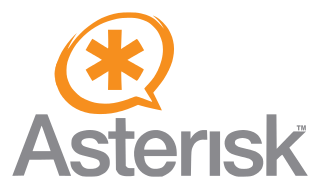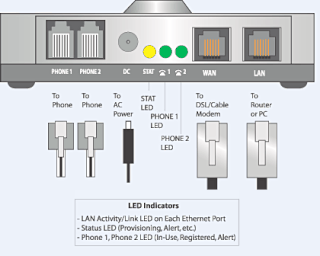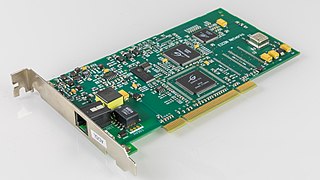The Digital Private Network Signalling System (DPNSS) is a network protocol used on digital trunk lines for connecting to PABX. It supports a defined set of inter-networking facilities.
The Session Initiation Protocol (SIP) is a signaling protocol used for initiating, maintaining, and terminating communication sessions that include voice, video and messaging applications. SIP is used in Internet telephony, in private IP telephone systems, as well as mobile phone calling over LTE (VoLTE).
Voice over Internet Protocol (VoIP), also known as IP telephony, refers to a set of technologies used for voice communication sessions over Internet Protocol (IP) networks, such as the Internet. VoIP enables voice calls to be transmitted as data packets, facilitating various methods of voice communication, including traditional applications like Skype, Microsoft Teams, Google Voice, and VoIP phones. Regular telephones can also be used for VoIP by connecting them to the Internet via analog telephone adapters (ATAs), which convert traditional telephone signals into digital data packets that can be transmitted over IP networks.

A media gateway is a translation device or service that converts media streams between disparate telecommunications technologies such as POTS, SS7, Next Generation Networks or private branch exchange (PBX) systems. Media gateways enable multimedia communications across packet networks using transport protocols such as Asynchronous Transfer Mode (ATM) and Internet Protocol (IP).
The public switched telephone network (PSTN) is the aggregate of the world's telephone networks that are operated by national, regional, or local telephony operators. It provides infrastructure and services for public telephony. The PSTN consists of telephone lines, fiber-optic cables, microwave transmission links, cellular networks, communications satellites, and undersea telephone cables interconnected by switching centers, such as central offices, network tandems, and international gateways, which allow telephone users to communicate with each other.

Asterisk is a software implementation of a private branch exchange (PBX). In conjunction with suitable telephony hardware interfaces and network applications, Asterisk is used to establish and control telephone calls between telecommunication endpoints such as customary telephone sets, destinations on the public switched telephone network (PSTN) and devices or services on voice over Internet Protocol (VoIP) networks. Its name comes from the asterisk (*) symbol for a signal used in dual-tone multi-frequency (DTMF) dialing.

An analog telephone adapter (ATA) or FXS gateway is a device for connecting traditional analog telephones, fax machines, and similar customer-premises devices to a digital telephone system or a voice over IP telephone network.

A business telephone system is a telephone system typically used in business environments, encompassing the range of technology from the key telephone system (KTS) to the private branch exchange (PBX).
Direct inward dialing (DID), also called direct dial-in (DDI) in Europe and Oceania, is a telecommunication service offered by telephone companies to subscribers who operate private branch exchange (PBX) systems. The feature provides service for multiple telephone numbers over one or more analog or digital physical circuits to the PBX, and transmits the dialed telephone number to the PBX so that a PBX extension is directly accessible for an outside caller, possibly by-passing an auto-attendant.
SIGTRAN is the name, derived from signaling transport, of the former Internet Task Force (I) working group that produced specifications for a family of protocols that provide reliable datagram service and user layer adaptations for Signaling System and ISDN communications protocols. The SIGTRAN protocols are an extension of the SS7 protocol family, and they support the same application and call management paradigms as SS7. However, the SIGTRAN protocols use an Internet Protocol (IP) transport called Stream Control Transmission Protocol (SCTP), instead of TCP or UDP. Indeed, the most significant protocol defined by the SIGTRAN group is SCTP, which is used to carry PSTN signaling over IP.

A VoIP phone or IP phone uses voice over IP technologies for placing and transmitting telephone calls over an IP network, such as the Internet. This is in contrast to a standard phone which uses the traditional public switched telephone network (PSTN).

Eicon Networks Corporation, formerly Eicon Technology Corporation, is a privately owned designer, developer and manufacturer of communication products founded on October 12, 1984, with headquarters in Montreal, Quebec, Canada. Eicon products are sold worldwide through a large network of distributors and resellers, and supplied to OEMs.
T.38 is an ITU recommendation for allowing transmission of fax over IP networks (FoIP) in real time.
A telephony system based on host media processing (HMP) is one that uses a general-purpose computer to process a telephony call’s media stream rather than using digital signal processors (DSPs) to perform the task. When telephony call streams started to be digitized for time-division-multiplexed (TDM) transport, processing of the media stream, to enhance it in some way, became common. For example, digital echo cancellers were added to long-haul circuits, and transport channels were shaped to improve modem performance. Then, in the mid-‘80s, computer-based systems that implemented messaging, for example, used DSPs to compress the audio for storage, and fax servers used DSPs to implement fax modems.
An IP PBX is a system that connects telephone extensions to the public switched telephone network (PSTN) and provides internal communication for a business. An IP PBX is a PBX system with IP connectivity and may provide additional audio, video, or instant messaging communication utilizing the TCP/IP protocol stack.

Elastix is a unified communications server software that brings together IP PBX, email, IM, faxing and collaboration functionality. It has a Web interface and includes capabilities such as a call center software with predictive dialing.
CT Connect is a software product that allows computer applications to monitor and control telephone calls. This monitoring and control is called computer-telephone integration, or CTI. CT Connect implements CTI by providing server software that supports the CTI link protocols used by a range of telephone systems, and client software that provides an application programming interface (API) for telephony functions.
SunComm Technology Co. Ltd. is a Taiwan multinational computer technology and GSM Voice over IP gateway manufacturer. The main products in 2010 focused on GSM VoIP gateways & IP surveillance camera devices. Core members have been engaging in the communication & networks industry since 1977.

The media gateway control protocol architecture is a methodology of providing telecommunication services using decomposed multimedia gateways for transmitting telephone calls between an Internet Protocol network and traditional analog facilities of the public switched telephone network (PSTN). The architecture was originally defined in RFC 2805 and has been used in several prominent voice over IP (VoIP) protocol implementations, such as the Media Gateway Control Protocol (MGCP) and Megaco (H.248), both successors to the obsolete Simple Gateway Control Protocol (SGCP).





